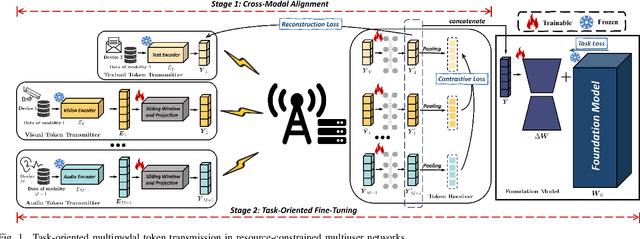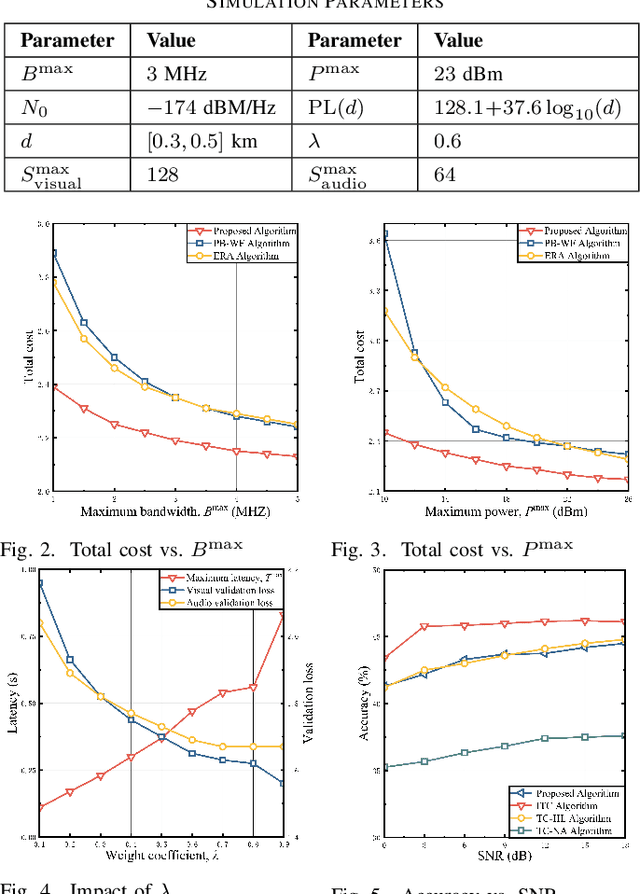Wanli Ni
Token Communication in the Era of Large Models: An Information Bottleneck-Based Approach
Jul 02, 2025Abstract:This letter proposes UniToCom, a unified token communication paradigm that treats tokens as the fundamental units for both processing and wireless transmission. Specifically, to enable efficient token representations, we propose a generative information bottleneck (GenIB) principle, which facilitates the learning of tokens that preserve essential information while supporting reliable generation across multiple modalities. By doing this, GenIB-based tokenization is conducive to improving the communication efficiency and reducing computational complexity. Additionally, we develop $\sigma$-GenIB to address the challenges of variance collapse in autoregressive modeling, maintaining representational diversity and stability. Moreover, we employ a causal Transformer-based multimodal large language model (MLLM) at the receiver to unify the processing of both discrete and continuous tokens under the next-token prediction paradigm. Simulation results validate the effectiveness and superiority of the proposed UniToCom compared to baselines under dynamic channel conditions. By integrating token processing with MLLMs, UniToCom enables scalable and generalizable communication in favor of multimodal understanding and generation, providing a potential solution for next-generation intelligent communications.
LLM Agent for Hyper-Parameter Optimization
Jun 18, 2025Abstract:Hyper-parameters are essential and critical for the performance of communication algorithms. However, current hyper-parameters tuning methods for warm-start particles swarm optimization with cross and mutation (WS-PSO-CM) algortihm for radio map-enabled unmanned aerial vehicle (UAV) trajectory and communication are primarily heuristic-based, exhibiting low levels of automation and unsatisfactory performance. In this paper, we design an large language model (LLM) agent for automatic hyper-parameters-tuning, where an iterative framework and model context protocol (MCP) are applied. In particular, the LLM agent is first setup via a profile, which specifies the mission, background, and output format. Then, the LLM agent is driven by the prompt requirement, and iteratively invokes WS-PSO-CM algorithm for exploration. Finally, the LLM agent autonomously terminates the loop and returns a set of hyper-parameters. Our experiment results show that the minimal sum-rate achieved by hyper-parameters generated via our LLM agent is significantly higher than those by both human heuristics and random generation methods. This indicates that an LLM agent with PSO knowledge and WS-PSO-CM algorithm background is useful in finding high-performance hyper-parameters.
Token Communication-Driven Multimodal Large Models in Resource-Constrained Multiuser Networks
May 06, 2025

Abstract:The proliferation of intelligent applications at the wireless edge, alongside the exponential growth of multimodal data, poses challenges for deploying multimodal large models (MLMs) in resource-constrained networks. These constraints manifest as limited bandwidth, computational capacity, and stringent latency requirements, particularly under low signal-to-noise ratio (SNR) conditions. To overcome these limitations, we propose a token communication paradigm that facilitates the decentralized deployment of MLMs across user devices and edge infrastructure (e.g., base stations). In this paradigm, task-relevant tokens are extracted from multimodal inputs and serve as the primary medium for communication between distributed model components. To align semantics and optimize transmission efficiency, we propose a dual-pronged approach: 1) We design a contrastive split fine-tuning method to project heterogeneous modalities into a shared feature space, enabling seamless interaction between model components while preserving modal-specific semantics. 2) We employ a lightweight compression technique to reduce the size of transmitted tokens, minimizing bandwidth consumption without sacrificing task-critical information. The proposed framework integrates collaborative fine-tuning of both the foundation model and multimodal transceivers, ensuring that token generation and utilization are tailored to specific downstream tasks. Simulation experiments conducted under different SNR conditions demonstrate that our method results in a $13.7\%$ improvement in test accuracy. Furthermore, our approach exhibits quicker convergence rates, even with reduced token lengths, highlighting the promise of token communication for facilitating more scalable and resilient MLM implementations in practical multiuser networks.
Task-Agnostic Semantic Communications Relying on Information Bottleneck and Federated Meta-Learning
Apr 30, 2025Abstract:As a paradigm shift towards pervasive intelligence, semantic communication (SemCom) has shown great potentials to improve communication efficiency and provide user-centric services by delivering task-oriented semantic meanings. However, the exponential growth in connected devices, data volumes, and communication demands presents significant challenges for practical SemCom design, particularly in resource-constrained wireless networks. In this work, we first propose a task-agnostic SemCom (TASC) framework that can handle diverse tasks with multiple modalities. Aiming to explore the interplay between communications and intelligent tasks from the information-theoretical perspective, we leverage information bottleneck (IB) theory and propose a distributed multimodal IB (DMIB) principle to learn minimal and sufficient unimodal and multimodal information effectively by discarding redundancy while preserving task-related information. To further reduce the communication overhead, we develop an adaptive semantic feature transmission method under dynamic channel conditions. Then, TASC is trained based on federated meta-learning (FML) for rapid adaptation and generalization in wireless networks. To gain deep insights, we rigorously conduct theoretical analysis and devise resource management to accelerate convergence while minimizing the training latency and energy consumption. Moreover, we develop a joint user selection and resource allocation algorithm to address the non-convex problem with theoretical guarantees. Extensive simulation results validate the effectiveness and superiority of the proposed TASC compared to baselines.
Multi-Task Semantic Communications via Large Models
Mar 28, 2025Abstract:Artificial intelligence (AI) promises to revolutionize the design, optimization and management of next-generation communication systems. In this article, we explore the integration of large AI models (LAMs) into semantic communications (SemCom) by leveraging their multi-modal data processing and generation capabilities. Although LAMs bring unprecedented abilities to extract semantics from raw data, this integration entails multifaceted challenges including high resource demands, model complexity, and the need for adaptability across diverse modalities and tasks. To overcome these challenges, we propose a LAM-based multi-task SemCom (MTSC) architecture, which includes an adaptive model compression strategy and a federated split fine-tuning approach to facilitate the efficient deployment of LAM-based semantic models in resource-limited networks. Furthermore, a retrieval-augmented generation scheme is implemented to synthesize the most recent local and global knowledge bases to enhance the accuracy of semantic extraction and content generation, thereby improving the inference performance. Finally, simulation results demonstrate the efficacy of the proposed LAM-based MTSC architecture, highlighting the performance enhancements across various downstream tasks under varying channel conditions.
Federated Intelligence: When Large AI Models Meet Federated Fine-Tuning and Collaborative Reasoning at the Network Edge
Mar 27, 2025Abstract:Large artificial intelligence (AI) models exhibit remarkable capabilities in various application scenarios, but deploying them at the network edge poses significant challenges due to issues such as data privacy, computational resources, and latency. In this paper, we explore federated fine-tuning and collaborative reasoning techniques to facilitate the implementation of large AI models in resource-constrained wireless networks. Firstly, promising applications of large AI models within specific domains are discussed. Subsequently, federated fine-tuning methods are proposed to adapt large AI models to specific tasks or environments at the network edge, effectively addressing the challenges associated with communication overhead and enhancing communication efficiency. These methodologies follow clustered, hierarchical, and asynchronous paradigms to effectively tackle privacy issues and eliminate data silos. Furthermore, to enhance operational efficiency and reduce latency, efficient frameworks for model collaborative reasoning are developed, which include decentralized horizontal collaboration, cloud-edge-end vertical collaboration, and multi-access collaboration. Next, simulation results demonstrate the effectiveness of our proposed methods in reducing the fine-tuning loss of large AI models across various downstream tasks. Finally, several open challenges and research opportunities are outlined.
* 8 pages, 6 figures
Channel Estimation and Beamforming Design for MF-RIS-Aided Communication Systems
Jan 18, 2025

Abstract:In this letter, we study the beamforming design for channel estimation of multi-functional reconfigurable intelligent surface (MF-RIS)-aided multi-user communications that supports simultaneous signal reflection, refraction, and amplification. A least square (LS) based channel estimator is proposed for MF-RIS by considering both the coupled MF-RIS beams and the introduced thermal noise. With the discrete fourier transform (DFT)-matrix, the MF-RIS beamforming design problem is simplified under the proposed LS channel estimator. The optimal MF-RIS beamforming design that achieves the Cram\'er-Rao lower bound (CRLB) of channel estimator is obtained with the proposed alternating optimization algorithm. Simulation results demonstrate the effectiveness of the proposed beamforming design in reducing the impact of thermal noise.
Federated Split Learning with Model Pruning and Gradient Quantization in Wireless Networks
Dec 10, 2024Abstract:As a paradigm of distributed machine learning, federated learning typically requires all edge devices to train a complete model locally. However, with the increasing scale of artificial intelligence models, the limited resources on edge devices often become a bottleneck for efficient fine-tuning. To address this challenge, federated split learning (FedSL) implements collaborative training across the edge devices and the server through model splitting. In this paper, we propose a lightweight FedSL scheme, that further alleviates the training burden on resource-constrained edge devices by pruning the client-side model dynamicly and using quantized gradient updates to reduce computation overhead. Additionally, we apply random dropout to the activation values at the split layer to reduce communication overhead. We conduct theoretical analysis to quantify the convergence performance of the proposed scheme. Finally, simulation results verify the effectiveness and advantages of the proposed lightweight FedSL in wireless network environments.
Multi-Functional RIS Integrated Sensing and Communications for 6G Networks
Dec 02, 2024



Abstract:In this paper, we propose a novel multi-functional reconfigurable intelligent surface (MF-RIS) that supports signal reflection, refraction, amplification, and target sensing simultaneously. Our MF-RIS aims to enhance integrated communication and sensing (ISAC) systems, particularly in multi-user and multi-target scenarios. Equipped with reflection and refraction components (i.e., amplifiers and phase shifters), MF-RIS is able to adjust the amplitude and phase shift of both communication and sensing signals on demand. Additionally, with the assistance of sensing elements, MF-RIS is capable of capturing the echo signals from multiple targets, thereby mitigating the signal attenuation typically associated with multi-hop links. We propose a MF-RIS-enabled multi-user and multi-target ISAC system, and formulate an optimization problem to maximize the signal-to-interference-plus-noise ratio (SINR) of sensing targets. This problem involves jointly optimizing the transmit beamforming and MF-RIS configurations, subject to constraints on the communication rate, total power budget, and MF-RIS coefficients. We decompose the formulated non-convex problem into three sub-problems, and then solve them via an efficient iterative algorithm. Simulation results demonstrate that: 1) The performance of MF-RIS varies under different operating protocols, and energy splitting (ES) exhibits the best performance in the considered MF-RIS-enabled multi-user multi-target ISAC system; 2) Under the same total power budget, the proposed MF-RIS with ES protocol attains 52.2%, 73.5% and 60.86% sensing SINR gains over active RIS, passive RIS, and simultaneously transmitting and reflecting RIS (STAR-RIS), respectively; 3) The number of sensing elements will no longer improve sensing performance after exceeding a certain number.
Two Birds With One Stone: Enhancing Communication and Sensing via Multi-Functional RIS
Oct 09, 2024



Abstract:In this article, we propose new network architectures that integrate multi-functional reconfigurable intelligent surfaces (MF-RISs) into 6G networks to enhance both communication and sensing capabilities. Firstly, we elaborate how to leverage MF-RISs for improving communication performance in different communication modes including unicast, mulitcast, and broadcast and for different multi-access schemes. Next, we emphasize synergistic benefits of integrating MF-RISs with wireless sensing, enabling more accurate and efficient target detection in 6G networks. Furthermore, we present two schemes that utilize MF-RISs to enhance the performance of integrated sensing and communication (ISAC). We also study multi-objective optimization to achieve the optimal trade-off between communication and sensing performance. Finally, we present numerical results to show the performance improvements offered by MF-RISs compared to conventional RISs in ISAC. We also outline key research directions for MF-RIS under the ambition of 6G.
 Add to Chrome
Add to Chrome Add to Firefox
Add to Firefox Add to Edge
Add to Edge